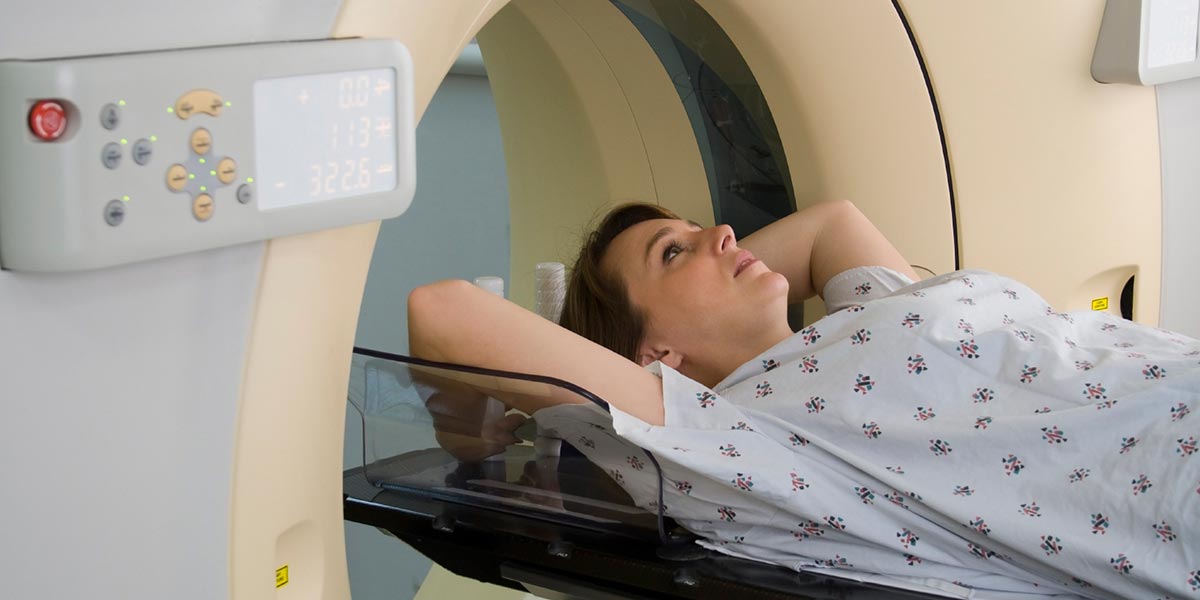Magnetic Resonance Imaging (MRI)
Magnetic resonance imaging (MRI) is a non-invasive technique utilizing a strong magnet together with radio waves and complex computer processing to produce unparalleled high resolution images of the internal organs and soft tissues of the body. Unlike traditional radiologic techniques, MRI does not use radiation or x-rays to obtain images. The exceptionally clear and detailed images allow the physicians of MBB to detect subtle differences between normal and diseased or injured tissue.
What is MRI? How Does it Work?
During an MRI scan, the patient is exposed to a strong magnetic field and painless radiofrequency waves. These waves enter the body and then echo back to a special receiver coil placed on the part of the body being imaged. The returning waves contain information about the inside of the body, and sophisticated computer processing turns that information into images with exquisite anatomic detail.
What is MRI Used For?
While MRI has revolutionized musculoskeletal and neurologic imaging, it has also become a valuable adjunct to computed tomography (CT) in imaging of the chest, abdomen, and pelvis.
Within the chest, some of the latest advances in MRI are being used to image the heart. MRI is very effective in evaluating how much cardiac tissue has been damaged in a heart attack, and this information can help determine if patients should undergo bypass surgery. The information from this exam can also be used to create a “movie” showing the beating heart in motion. This allows the radiologist to evaluate whether the actual function of the heart is impaired and to what degree. MRI is also frequently used to evaluate the aorta and other blood vessels.
In the abdomen, MRI shines in its ability to definitively characterize lesions of the liver, pancreas, kidneys, and adrenal glands. In many cases, MRI can determine if tumors are benign or malignant without the need for surgery or a biopsy. If a tumor is found to be malignant, the radiologist can use the images to help the surgeon plan the safest possible operation.
Within the pelvis, MRI is very effective in evaluating the uterus in patients suspected to have fibroids or other conditions causing pain or abnormal bleeding. MRI of the pelvis also provides valuable diagnostic information in the setting of infertility, pelvic floor dysfunction, or cancers of the ovaries, cervix, prostate, or rectum. In many cases, the radiologist uses detailed MRI images to assist treating surgeons and oncologists in deciding the best course of treatment for pelvic malignancies.
MR angiography (MRA) is a sensitive, non-invasive means of evaluating the blood vessels. Though most commonly used to study the arteries and veins supplying and draining the brain, this technique may be applied to almost any vessel in the body. While MRA traditionally required the injection of a “dye” into the veins, newer techniques have been shown to be almost just as accurate without the need for a contrast injection.
What to Expect During an MRI Exam
Before your exam, a specially trained MRI technologist will discuss the exam with you, review your medical history, and answer any questions you may have. He or she will be in contact with you throughout the exam, keeping you informed and providing support.
MRI exams are painless, but they do require you to lay fairly still for 20-45 minutes. For the exam, you will lie on a padded scanning bed. While most patients lie on their backs, your position may vary depending upon the type of exam and body part being imaged. The technologist performing the study will not stay in the room during the exam. He or she will be in a control room operating the MRI scanner. The technologist will be watching you through a glass window, and you will be able to communicate by intercom throughout the exam.
When images are being acquired, the MRI scanner makes loud “knocking” noises—caused by the rapidly shifting magnetic fields. You will be given earplugs to dampen the noise, and you may be given headphones to listen to the music of your choosing.
You may be asked to hold your breath for short periods of time, and you will be asked to hold as still as possible for intervals of several minutes at a time. During these periods, the scanner is creating pictures of your internal organs. Much like a photograph, movement will cause the image to blur—making it more difficult for your doctors to diagnose and treat your condition.
In order to provide greater diagnostic information, some MRI scans are performed with intravenous contrast. This dye is made with the element gadolinium—a relatively inert compound with a very low incidence of allergic reaction. For certain exams of the bowel and bile ducts, you may be asked to drink an oral contrast agent shortly before the exam.
How to Prepare for an MRI Exam
Wear comfortable, loose clothing that does not have zippers or other metal fasteners. If this is not possible, you may be asked to change into a gown so that metal on your clothing does not interfere with the MRI. If this is the case, you will be shown to a private changing room.
Before the exam, a technologist will ask you a few medical questions and explain your exam before assisting you into the MRI scanning room.
MRI is very safe, and there are no health risks associated with the magnetic field or the radio waves used by the machine. However, there are some special circumstances that limit the use of strong magnetic fields, so it is important that you let the technologist know if you have any of the following:
- Cardiac pacemaker, internal defibrillator, stent, or artificial heart valve.
- Insulin or other infusion pump.
- Aneurysm clip.
- Cochlear implant
- Artificial joint, metallic plate, pin, or other metallic implant.
- Intrauterine device
While some of the above medical devices do not present a problem, others are not compatible with the MRI scanner. If you have any of the above devices, you may want to call the department before your appointment to ensure that you are a candidate for an MRI exam. If possible, please bring any information you may have about your implantable medical device.
For all MRI exams, it is also important to let the technologist know of any of the following:
- If you are pregnant or think there is a chance you could be pregnant.
- If you are allergic to any medications or intravenous contrast.
- If you have kidney disease or renal failure.
- If you have liver disease.
- If you have a history of metalworking or have ever had a fragment of metal get in your eye.
- If you have a history of prior gunshot wound.
- If you have permanent (tattoo) eye-liner.
Please note that pregnant women may undergo MRI examinations; however, they should discuss the exam with their ordering physician and/or radiologist before the study. While there are no known adverse effects of MRI scanning on the developing baby, it is recommended that imaging not be performed until the second trimester, if possible.
While the images are being obtained, you will be lying in a tube that creates the magnetic field. Over the years, advances in technology have allowed these tubes to be made wider; however patients with claustrophobia may still feel uncomfortable and unable to tolerate the exam. If you are prone to claustrophobia or panic attacks, please discuss this with your physician. He or she may wish to prescribe an anti-anxiety medication for you to take prior to your exam. In our experience, most claustrophobic patients are then able to complete an MRI without difficulty. If you do take such a medication before your exam, please be sure a friend or family member comes with you, as you will need someone to drive you home.
After complex computer processing, data from your MRI exam will be used to create hundreds, or even thousands, of detailed images. These images will be analyzed and interpreted by an MBB radiologist, and a report of his or her findings will be provided to your physician.



